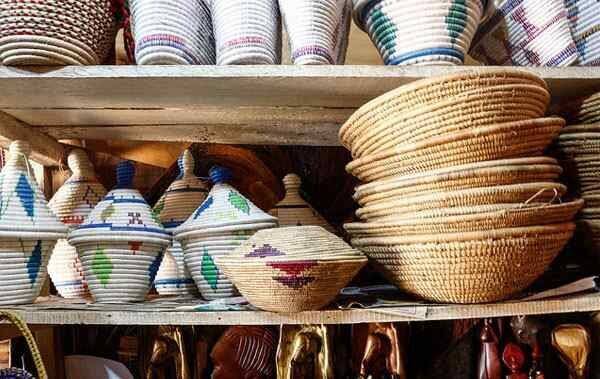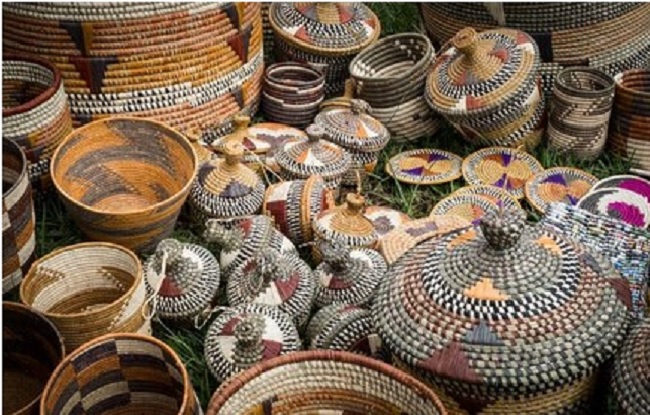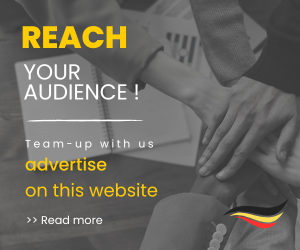Uganda art and crafts experiences and tours allows you to explore the country’s culture and history with 50 indigenous communities. Explore the art of weaving baskets and bark cloth making. Learn about the variety of bananas and ways of cooking and making beer and juice out them.
We invite you to visit women groups that make art and crafts. At the Uganda Safari Travel Guide we believe in sustainable / Eco-Tourism. That is why we present in first place Uganda safari tours that follow the policies to preserve our natural habitats and cultural heritage.
The art and crafts tours in Uganda include private visits to weaving associations. For example, the Busimba women at Rest in Banana Gardens near Kibale Forest National Park. Ride 4 a woman in Buhoma sector northern part of Bwindi Impenetrable Forest National Park. And the Boma women’s group in Murchison Falls National Park.
Come and meet the local crafts women and make new friends. This highlights how cultural tourism in Uganda can advance gender equality and women empowerment especially after covid-19 pandemic. That of course is part of the Sustainable Tourism Development Goal 5.
Basket weaving
The history of basket weaving in Africa and many cultures in the world is not easy to determine. But, in Uganda you can learn how it started as well other forms of weaving such as mats. Basketry is one of the sustainable ways our ancestors passed down from generation to another. Above all, baskets are known to last longer which is a good thing for mother nature.
With expert guidance, you can learn how to weave a basket or mat in Bigodi community near Kibale Forest National Park. The art and crafts experience is also available at Bomu Women’s Center near Kicumbanyobo the southern entrance gate of Murchison Falls National Park. The Ride 4 A Woman Center in Buhoma can be visited after gorilla trekking in Bwindi.
Teaching and learning basket weaving is now a common skill in institutions of learning. The African Craft Village behind Uganda National Theater in Kampala capital city offer lessons on basket weaving.
Methods of basket weaving
Largely done by women in rural areas nearby lakes and swamps where it’s to access the resources. Basketry in Uganda consist the use of natural plants as raw materials. For instance, Ugandan baskets are largely made of banana fibers, dried palm tree leaves, papyrus reeds and sisal to make several products by hand.
There are three known methods of weaving including coiling, twining and cordage. All involve use of iron owls. The easiest to learn is coiling which involves weaving around a circle. Cordage is similar to rope making whereas twining involves use of handles sticks or spokes. For the skilled, weaving a large basket can take a month and less than a week for a small food keeping one.
Among the Banyankole and Baganda basket weaving involves use of Imigongo patterns. This kind of art is originating in Rwanda where Agaseke baskets are a national symbol and can be seen in the architectural design of Kigali Convention Center (KCC). Furthermore, the BaTong of Zambia and Zimbabwe are famous for their spider web and lighting basket weaving patterns.

Innovations to shun carbon heavy, non-biodegradable plastics
The traditional materials are now complimented by use of plastics such as drinking straws, beads and foils. This helps to add decorative designs making baskets more beautiful and attractive to the customer. In that regard, basketry in Uganda has grown beyond traditional agricultural usage to poverty alleviation. Now it’s recognized as a form of pro-poor tourism. Because it directly benefits the women involved in weaving and selling of baskets.You can obtain them a gifts or souvenirs in craft markers of Kampala capital city that sell Ugandan baskets.
Basketry as a form of pro-poor tourism in Northern Uganda
The art of weaving is soothing but will also reveal various legends attached to it. Most importantly, you will support the livelihoods of women while fostering environment conservation. For instance, in Teso and Karamoja regions basket weaving was fronted to support livelihood opportunities. The strategy was part of the Northern Uganda Rehabilitation Program (NURP) that intervened after the war in northern Uganda.
Furthermore, a common highlight of northern Uganda is to take a trip to see the Karamojong and Ik in Kidepo Valley National Park.

Use of baskets
The usage of baskets is wide ranging in East and Southern African cultures. The most common is presentation of baskets as gifts to the newlywed during traditional marriage ceremonies. In particular, the Banyankole of western Uganda use baskets for serving food millet bread (Akaro). Likewise, among the Baganda baskets known as “Ebibbo??? are used for steaming Matooke (banana) among others such as initiation of children into family. The Batooro and Banyoro of western Uganda use baskets for keeping and serving coffee beans.
There are several types of baskets amongst each tribe. For instance, in Sesse islands Lake Victoria, the fishermen use baskets for beer straining and fish trapping.
Challenges of basketry in Uganda
Plant based materials such as papyrus reeds are getting scarce due to forest degradation. However, there has been conservation of protected areas and creation of buffer zones. The Uganda Wildlife Authority through the department of Community Conservation allows communities adjacent to national parks to access raw materials.
Another challenge of basketry in Uganda poor quality products on the market and inadequate marketing. As indicated by the Uganda National Cultural and Uganda Monuments Policy, there’s need for carrying out research about raw materials used in weaving of different products.
The ancient art of making Bark cloth
Another spectacular Uganda art and crafts experience is bark cloth making.
Bark cloth is an ancient handicraft which is believed to have been invented before weaving. The papery fabric is made from the bark of a tree such as Mutuba (Ficus natalensis) in central Uganda usually by retting and beating to produce clothing. However, bark cloth is also made from other tree species such as elm and paper mulberry native to South-East Asian, central America, Caribbean and pacific islands.
Initially produced as a necessity for covering, the value of bark cloth has grown significantly beyond cultural traditions. For instance, several products are made out of bark cloth such as clothing, souvenirs, accessories, mats, bedding and home furnishings.
Despite the increased value, the usage of bark cloth has been changing. Due to several factors such as introduction of cotton fabrics, religious beliefs and loss of trees. To that end, bark cloth is now like a precious gem among the few communities where it still survives.
Bark cloth in Uganda is only produced by Ngonge one of the 52 clans of Buganda kingdom in central part of Uganda. Visit the village of Bukomansimbi in Masaka district the center of bark cloth production. Bukomansimbi is 153 sq.km (3-hour drive) south-west of Kampala capital city. The experience needs to be planned in advance to allow preparation.
How bark cloth is made in Masaka, Buganda
The process of bark cloth making has seldom changed for ages. It’s done by men who use machetes to strip the bark of a mature Mutuba tree preferably of a rectangle shape. Once the bark is got from the tree, its then soaked by steaming to make it soft.
After softening, its beaten with wood or stones over a hard surface usually large tree log. The bark fiber slowly softens as it stretches and eventually turns into bark cloth after drying. Artists can decorate the bark cloth to make art pieces while others tailor it to make several products. Already made bark cloth products include bags, shirts, beddings and jackets.
Massive deforestation could lead to loss of Mutaba trees
Mutuba trees are getting lost due to deforestation. This possess a serious challenge to bark cloth production. Now, this tree is being conserved and more people are trained in the making of bark cloth through Bukomansimbi Organic Tree Farmers Association (BOTFA). Through the Buganda clan system, the bark cloth has greatly been preserved as a symbol of royal heritage. As a result, Buganda bark cloth was recognized by UNESCO under Oral and Intangible Cultural Heritage of Humanity.
Read more about Uganda Art and Crafts experience? Go to Culture Tours



 Uganda Safari Travel Guide Advert
Uganda Safari Travel Guide Advert


